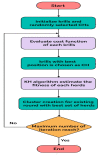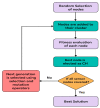Enhanced Dual-Selection Krill Herd Strategy for Optimizing Network Lifetime and Stability in Wireless Sensor Networks
- PMID: 37687941
- PMCID: PMC10490580
- DOI: 10.3390/s23177485
Enhanced Dual-Selection Krill Herd Strategy for Optimizing Network Lifetime and Stability in Wireless Sensor Networks
Abstract
Wireless sensor networks (WSNs) enable communication among sensor nodes and require efficient energy management for optimal operation under various conditions. Key challenges include maximizing network lifetime, coverage area, and effective data aggregation and planning. A longer network lifetime contributes to improved data transfer durability, sensor conservation, and scalability. In this paper, an enhanced dual-selection krill herd (KH) optimization clustering scheme for resource-efficient WSNs with minimal overhead is introduced. The proposed approach increases overall energy utilization and reduces inter-node communication, addressing energy conservation challenges in node deployment and clustering for WSNs as optimization problems. A dynamic layering mechanism is employed to prevent repetitive selection of the same cluster head nodes, ensuring effective dual selection. Our algorithm is designed to identify the optimal solution through enhanced exploitation and exploration processes, leveraging a modified krill-based clustering method. Comparative analysis with benchmark approaches demonstrates that the proposed model enhances network lifetime by 23.21%, increases stable energy by 19.84%, and reduces network latency by 22.88%, offering a more efficient and reliable solution for WSN energy management.
Keywords: dual mechanism; exploitation; exploration; krill herd; latency; stability.
Conflict of interest statement
The authors declare no conflicts of interest.
Figures



















References
-
- Jia D., Zhu H., Zou S., Hu P. Dynamic Cluster Head Selection Method for Wireless Sensor Network. IEEE Sens. J. 2016;16:2746–2754. doi: 10.1109/JSEN.2015.2512322. - DOI
-
- Li B., Zhang M., Rong Y., Han Z. Transceiver Optimization for Wireless Powered Time-Division Duplex MU-MIMO Systems: Non-Robust and Robust Designs. IEEE Trans. Wirel. Commun. 2022;21:4594–4607. doi: 10.1109/TWC.2021.3131595. - DOI
-
- Karaboga D., Okdem S., Ozturk C. Cluster based wireless sensor network routing using artificial bee colony algorithm. Wirel. Netw. 2012;18:847–860. doi: 10.1007/s11276-012-0438-z. - DOI
-
- Cao K., Wang B., Ding H., Lv L., Tian J., Hu H., Gong F. Achieving Reliable and Secure Communications in Wireless-Powered NOMA Systems. IEEE Trans. Veh. Technol. 2021;70:1978–1983. doi: 10.1109/TVT.2021.3053093. - DOI
-
- Pal V., Singh G., Yadav R.P. Cluster Head Selection Optimization Based on Genetic Algorithm to Pro-long Lifetime of Wireless Sensor Networks. Procedia Comput. Sci. 2015;57:1417–1423. doi: 10.1016/j.procs.2015.07.461. - DOI
Grants and funding
- CZ.10.03.01/00/22_003/0000048/European Union under the REFRESH - Research Ex-cellence For REgion Sustainability and High-tech Industries via the Operational Programme Just Transition
- CZ.02.1.01/0.0/0.0/16_019/0000867/European Regional Development Fund in the Research Centre of Advanced Mechatronic Systems within the Operational Programme Research, Development, and Education
LinkOut - more resources
Full Text Sources

